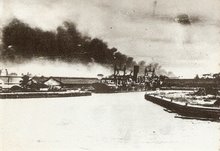IT was a war in which a combination of fast-changing events and censorship combined to endow a strange kind of time-lag on the observer.
It was the end of January 1942 and South Shields seaman Thomas Umpleby, of Palmerston Street in the town, is pictured receiving the Lloyds War Medal for an earlier act of bravery at sea.
Yet even as the paper went to press, as the adjacent headline shows, events were building in the Far East that, unbeknown for some time to readers, were already calling for local seafarers to show similar courage.
Among them were the crew of the Empire Star. She had come out of the yard of Harland and Wolff at Belfast half a dozen or so years earlier; at more than 11,000-tons gross, she was a smart, modern addition to the Blue Star fleet.
By the end of the year, she would be gone, sunk by a German U-boat north of the Azores, while in passage from the UK to South Africa.

Among those who went down with her was her first electrician, 29-year-old South Shields man Ernest Dudgeon.
But it was her exploits inbetween that concern us today for, a few months earlier, the Empire Star and her people had played a distinguished role in one of the most nail-biting episodes of the Second World War – the evacuation of Singapore.
In all, she would help more than 2,000 people to safety as the Japanese advanced on Britain’s major military base in south-east Asia.
The story of the ship’s part in the famous evacuation is told in a booklet which has been compiled by Hartlepool writer June Markwell, with Arthur Glendenning, in the hope that it will bring to the fore someone – anyone – who knows why there is a memorial to the Empire Star’s part in this wartime episode in a church, Holy Trinity, in Seaton Carew.
“No trace can be found of the person or persons who gave it,” they say.
Might the family of Sidney Milne know, for instance? He was from Jarrow and was the Empire Star’s carpenter. Aged 40 at the time, he’s unlikely to still be alive.
But, says June: “Hopefully he may have survived the war and his family may have some information.”
The ship’s part in the evacuation is certainly a thrilling one.
Her orders, for instance, had been to take off women and children, together with designated air force personnel and military nursing staff.
As well, though, she found herself invaded by army deserters, many of them Australian.
Also, her crew was added-to by several men classed as DBS (Distressed British Seamen) who had survived the sinking, five days after the headlines here, of the Canadian Pacific passenger liner, Empress of Asia, which had been bombed while carrying more than 2,000 troops from Bombay.
* If anyone has any information relating to the Empire Star memorial at Seaton Carew, get in touch and I’ll pass on contact details.
* S.S. Empire Star: The Mystery of a Church War Memorial, is available, price £2.95 plus p&p, from Hartlepool Maritime Experience (tel 01429 860077), or Atkinson Print, Hartlepool (tel 01429 267849



